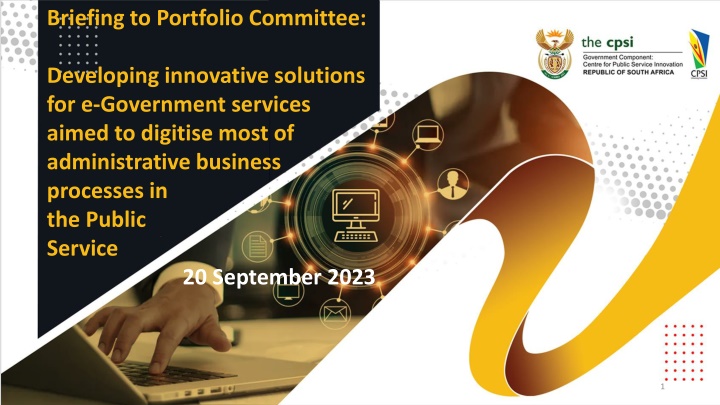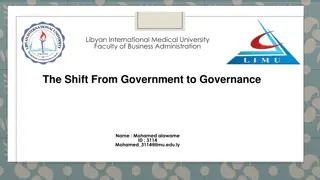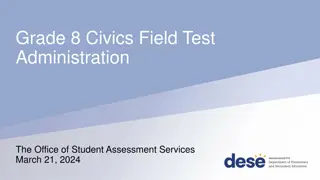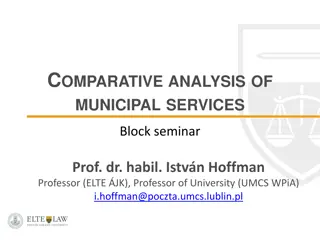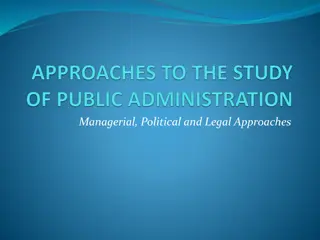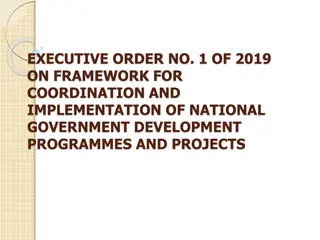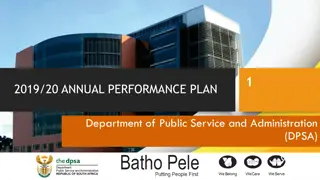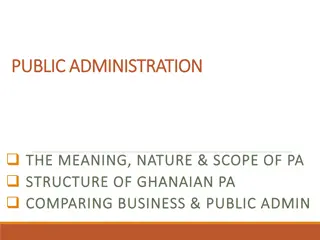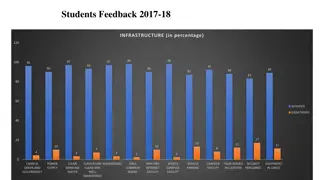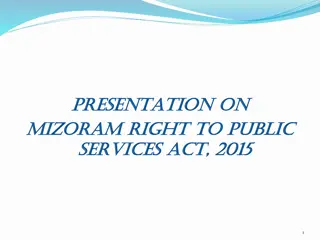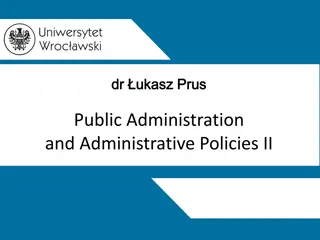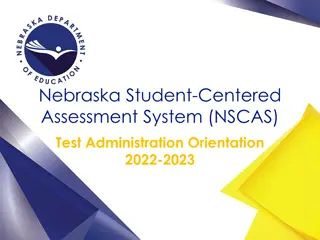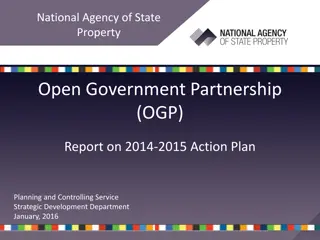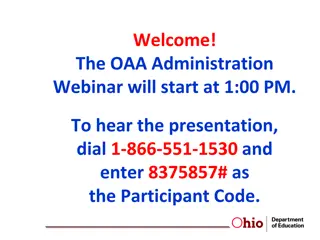Innovating e-Government Services for Efficient Public Administration
Developing innovative solutions for e-Government services to digitize administrative processes in the Public Service, emphasizing roles, responsibilities, digitization importance, approach, enabling conditions, and examples. Highlighting the Minister's responsibilities in establishing norms, standards, and ICT resource management. Discussing the Electronic Communication and Transaction Act, eGovernment Strategy, and the digitization of government internal processes for efficiency, cost savings, innovation, and new service delivery models.
Download Presentation

Please find below an Image/Link to download the presentation.
The content on the website is provided AS IS for your information and personal use only. It may not be sold, licensed, or shared on other websites without obtaining consent from the author.If you encounter any issues during the download, it is possible that the publisher has removed the file from their server.
You are allowed to download the files provided on this website for personal or commercial use, subject to the condition that they are used lawfully. All files are the property of their respective owners.
The content on the website is provided AS IS for your information and personal use only. It may not be sold, licensed, or shared on other websites without obtaining consent from the author.
E N D
Presentation Transcript
Briefing to Portfolio Committee: Developing innovative solutions for e-Government services aimed to digitise most of administrative business processes in the Public Service 20 September 2023 1
1.ROLES AND RESPONSIBILITIES 2.THE IMPORTANCE OF DIGITISATION 3.APROACH 4.EXAMPLES 5.WHAT IS NEEDED: ENABLING CONDITIONS 2
PSA 3(1) The Minister is responsible for establishing norms and standards relating to- (b) the organisational structures and establishments of departments and other organisational and governance arrangements in the public service; (f) information management in the public service; (g) electronic government; (i) transformation, reform, innovation and any other matter to improve the effectiveness and efficiency of the public service and its service delivery to the public. PSR (s93): Acquisition, management and use of information and communication technology resources. The head of department shall ensure that the acquisition, management and use of information and communication technologies by the department a) enhances direct or indirect service delivery to the public, including, but not limited to, equal access by the public to services delivered by the department (b) improves the productivity of the department (c) promotes an environmentally friendly public service and (d) ensures cost efficiency for the department. 3
Electronic Communication and Transaction Act of 2002 and eGovernment Strategy (2017) Management of electronic signatures Roadmap for eGovernment implementation SITA Act (s7 (1) b - may services): (ii) application software development; (iii) maintenance services for information technology software or infrastructure; (iv) data-processing or associated services for departmentally specific information technology applications or systems; 4
Digitisation of government internal processes critical for: Achieving greater efficiencies Cost and time savings Enabling innovation, new processes and procedures Opportunity for new service delivery models Reduce cost of Progamme 1 (administration) Reduce cost of M&E and auditing Enable data-driven decision-making Enable real-time or near-real-time monitoring and decision-making Cannot separate internal and external digitisation services -up Bottom-up and in-house vs bigbang top-down service providers Caution against dangers of lock-in by technology service providers. 5
Provide thought leadership (E.g. dialogues on eGov, GovTech Incubator with Wits School of Governance PSI Awards Programme as feeder programme Identify innovative digitisation projects for further support Replication of at least two projects per year (2 employees) Development of new digitisation projects (2 employees) Two projects under development Currently 15 projects in the pipeline Digitise internal systems then facilitate replication Building community of internal systems developers (trailblazers) Recognition Code-sharing and support (high demand from provinces) 6
CPSI Development: EMS Patient Transfer Digitising and virtualising Thusong Service Centres CPSI Replication: Digital fingerprint Gauteng to National eLearning: Learner Management Systems Network of developers in government eLeave, eRecruitment, ePerformance Management, EMS systems, Demand Plans, remote monitoring (robotics and IoTs), digitisation of X-Rays, etc. 7
Capacity: CPSI has one permanent position for a developer. Require small agile teams with various competencies (business analysts, change management, systems developers, cyber-security, identity management, etc.) Need systems developers in departments where there are, these developers are saving government millions (e.g. BizPortal) Key enablers: Sovereign Digital Identity Legislative Review (to identify barriers such as Z-forms) Design & development principles (inclusion, trust, transparency, digital-by-design, secure-by-design) Secure, affordable, high speed broadband to enable digitised environment (e.g. 2MB line constraints ) Systems view: Role clarification, including eGov Strategy implementation & SITA vis- -vis internal capacity Interoperability, APIs and IP Management National and provincial coordination for replication of existing innovations Lifting of NT moratorium 8
THANK YOU 9 9
